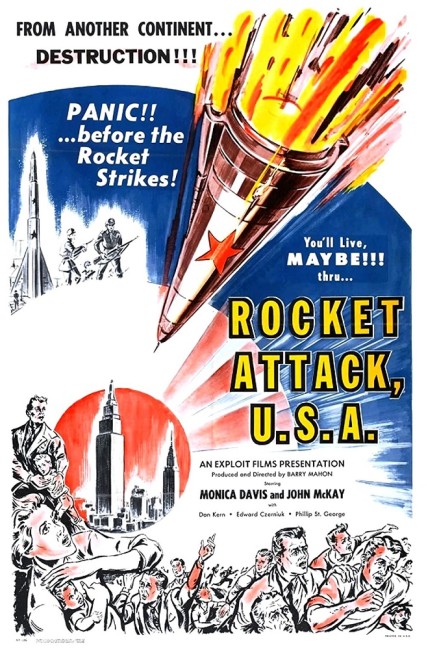Crew
Director/Producer – Barry Mahon, Photography (b&w) – Mike Tabb, Music – RFT Music Publishing Co Ltd. Production Company – Exploit Films.
Cast
John McKay (John Manston), Monica Davis (Tania), Phillip St George, Edward Czerniuk, Daniel Kern, Richard Downs, Herbert Flato, Ray Brewer, Janice Gilmain, Robert Reeh, Arthur Metrano, Jane Ross, Marco Behar, Frank Patrinostrow, Milton Fuchs, William Osborn, Ronnie Cooper, John Horner, Nicolai Grushko, Sara Amman, Vladovia Lazarett, James Tura, Alan Smiler
Plot
The USA detects a Russian satellite in orbit that is sending information about the US back to the Soviet Union. This could well give the Russians what they need for supremacy in space, including the ability to build ICBMs. A Central Intelligence Organization agent obtains information about the Russian military program from a spy who has managed to become the mistress of the Russian Minister of Defense. As a military clique takes over in Russia, a general back home tries to persuade the US government of the necessity of building a strong missile program to respond to the Soviet threat.
Rocket Attack U.S.A. is a truly remarkable 1950s artifact. It is a piece of Red Scare hysteria that ranks right up there alongside works such as Invasion USA (1952) and Red Planet Mars (1952) in its blatant propagandism. The film was made directly after the launch of Sputnik and it is driven by an overriding dread about who will win the supremacy of space and who will develop the first ICBM.
The film’s rampant sense of alarmism is incredible – lines like: “If only we had an operating anti-missile device, we could give some hope to those people out there.” Most remarkable – particularly in hindsight of the Reagan administration who nearly wrecked the national economy and slashed social services in the service of these very fears – are the complaints by the military about the lack of interest by politicians in funding proper weapons build-up. “If we had the money that was appropriated for such ‘worthy’ projects as cheese price supports we would have had our ICBM long ago,” bemoans the General.
The end credit on a nuclear-devastated New York states: “In spite of the selfish interests of political factions or special interest groups … we cannot allow this to be … The End!” Much of the nonsense of the whole Duck and Cover public hysteria is perpetuated by the film – with scenes of New York civil authorities advising people to protect themselves from the bomb blast by covering themselves in wet newspaper.
The film appears to have been opportunistically constructed by using stock footage from the American space program. Almost half the film consists of stock footage of the construction and test of American ICBMs. One is not sure if the scenes set in the Russian politburo are stock or not. They certainly appear so, even down to the narrator describing what they are saying to one another, “The War Minister says …”, “The Minister replies …” and so on.
The original dramatic footage shot for the film is dull. Several scenes – the ones with John McKay waiting for Monica Davis in a Russian restaurant or the scenes of the Russian launch, which are intercut with interminable shots of the same computer reel spinning around – drag on forever. The film is produced by a company with the unfortunate name of Exploit Films.
Elsewhere, director Barry Mahon (1921-99) is mostly known for a series of nudie films throughout the 1960s. He did make the horror films The Dead One (1961) and The Beast That Killed Women (1965), a psycho film set at a nudist camp, as well as the horror nudie Fanny Hill Meets Dr Erotico (1967) that features a monster. Aside from that, Mahon also made a series of fairytale adaptations in terms of 1960s psychedelia with The Wonderful Land of Oz (1969), Jack and the Beanstalk (1970), Thumbelina (1970) and Santa’s Christmas Elf (Named Calvin) (1971)
Full film available online here:-

